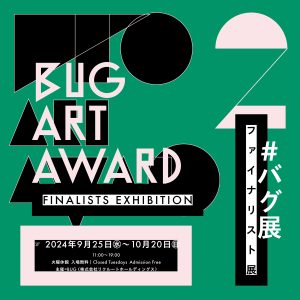
We are pleased to present a group exhibition featuring the six artists who have passed the first two rounds of the selection process to become finalists for the 2nd BUG Art Award. On October 8th (Tues), we will hold a public final selection round, upon which we will determine the recipient of the grand prize. The selected winner will hold a solo exhibition at BUG roughly one year later, receiving a maximum 3 million yen creation budget (including setup and deinstallation), along with an additional artist fee.
The BUG Art Award is given to early career artists by Recruit Holdings Co., Ltd. The selection committee fosters the artists’ growth throughout the jury process, offering support such as artistic feedback, advice on exhibitions and their preparations, and more. We hope to encourage the pursuit of new forms of expression, and of their futures in the field of art.
The plan for the exhibition is decided by the six finalists, who discuss the artwork placement and use the BUG space to simulate its installation. These six artists were selected from a pool of 265 applicants. We hope you will be as excited to see their exhibition as we are.
Lastly, we present the finalists’ comments on the exhibition plan.
(in alphabetical order by name)
Mariko ARAI “Scapegoat”
This is a new technological “entity” born from AI image generation. The entity was generated through the use of a variety of techniques to replicate and edit massive numbers of images, blurring generation and reproduction and throwing originality into question. Where, here, is the criterion for determining types or distinctions? Starting with the destruction of categories (classifications), as well as the infringement and evasion of legal systems such as copyright protections, I explore the ambiguous similarities and differences in products—and, by extension, in humans.
Umi IWASE “SRS Series”
I am working on sculptures concerning gender, sexuality, and related issues.
My artwork is often made from a variety of materials, such as animal or human hair, wood, gypsum, iron, or FRP.
The SRS series was created while reflecting on the means by which this country determines the sex of an individual, with the preexisting legal system as a starting point.
The works allude to the strained ambivalence of the situation into which the medical and legal systems place affected communities: violent, yet somehow fleeting.
Hinako MIYABAYASHI “Between the Hands”
I paint as a “hand” that “accepts” the individual textures and all else that comes with each material: coarsely woven cloth or fine cotton, wood or paper. When I assume I am stretching my own hand out to paint the image, this “accepting hand” comes to me, takes me in, and sets me free. And thus we move together.
As I sit down to paint, I do not lose sight of all that exists around us. Physical distance is not reducible to gesture, but exists in tandem with space (temperature, humidity, and so on).
Shota SHIMURA “Mobile Literature Tokyo Boys & Girls”
The Mobile Literature series is a collection of works that seek to integrate physical movement and projection technology with literary expression by treating the city as a canvas to depict works of fiction set in the areas where the pieces are shown, using a bicycle retrofitted with a video device. This work, Mobile Literature: Tokyo Boys and Girls, sees three fictional pieces set in the BUG-adjacent Yurakucho, Ginza, and Nihombashi neighborhoods. I edit the words into videos, and will exhibit documentation of each projected text as I cycle through its corresponding neighborhood.
Yuichi SHIROMA “A certain place”
I use the medium of painting to produce, as if a sort of being were emerging, the ethos of the varied relations that tie person to person. Recently, I have become interested in motifs and the contexts that surround them (the places in which they are placed); dismantling these ambiguous connections and rejoining them, I research pictorial space. My other experiments involve taking information about us that has been pulled apart and, as if it were a puzzle, putting it back together slightly incorrectly, with the results depicted in painting as one uncanny mass.
Yasutaka YANO “See-through”
This exhibition consists of three components: (1) paintings depicting the artist’s attributes and/or related motifs and encounters, (2) an independent exhibition space, and (3) “flashcards” explaining words used in the exhibition.
The paintings blur the distinctions between attributes of the artist and motifs he has encountered; the flashcards set adrift the meanings of words or phrases welded to these motifs/attributes/categories. The exhibition space, put together by the artist himself, is set up so as to allow these drifting paintings and words to float around, to freely come and go.
Information
Date: 2024.9.25WED — 10.20SUN
Opening Hours: 11:00 — 19:00


